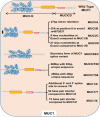Crosstalk between MUC1 and VEGF in angiogenesis and metastasis: a review highlighting roles of the MUC1 with an emphasis on metastatic and angiogenic signaling
- PMID: 33836774
- PMCID: PMC8033681
- DOI: 10.1186/s12935-021-01899-8
Crosstalk between MUC1 and VEGF in angiogenesis and metastasis: a review highlighting roles of the MUC1 with an emphasis on metastatic and angiogenic signaling
Abstract
VEGF and its receptor family (VEGFR) members have unique signaling transduction system that play significant roles in most pathological processes, such as angiogenesis in tumor growth and metastasis. VEGF-VEGFR complex is a highly specific mitogen for endothelial cells and any de-regulation of the angiogenic balance implicates directly in endothelial cell proliferation and migration. Moreover, it has been shown that overexpressing Mucin 1 (MUC1) on the surface of many tumor cells resulting in upregulation of numerous signaling transduction cascades, such as growth and survival signaling pathways related to RTKs, loss of cell-cell and cell-matrix adhesion, and EMT. It promotes gene transcription of pro-angiogenic proteins such as HIF-1α during periods of oxygen scarcity (hypoxia) to enhance tumor growth and angiogenesis stimulation. In contrast, the cytoplasmic domain of MUC1 (MUC1-C) inhibits apoptosis, which in turn, impresses upon cell fate. Besides, it has been established that reduction in VEGF expression level correlated with silencing MUC1-C level indicating the anti-angiogenic effect of MUC1 downregulation. This review enumerates the role of MUC1-C oncoprotein and VEGF in angiogenesis and metastasis and describes several signaling pathways by which MUC1-C would mediate the pro-angiogenic activities of cancer cells.
Keywords: Angiogenesis; Cancer; MUC1; Targeted therapy; VEGF; VEGFR.
Conflict of interest statement
The authors declare that they have no competing interests.
Figures



References
Publication types
LinkOut - more resources
Full Text Sources
Other Literature Sources
Research Materials
Miscellaneous

